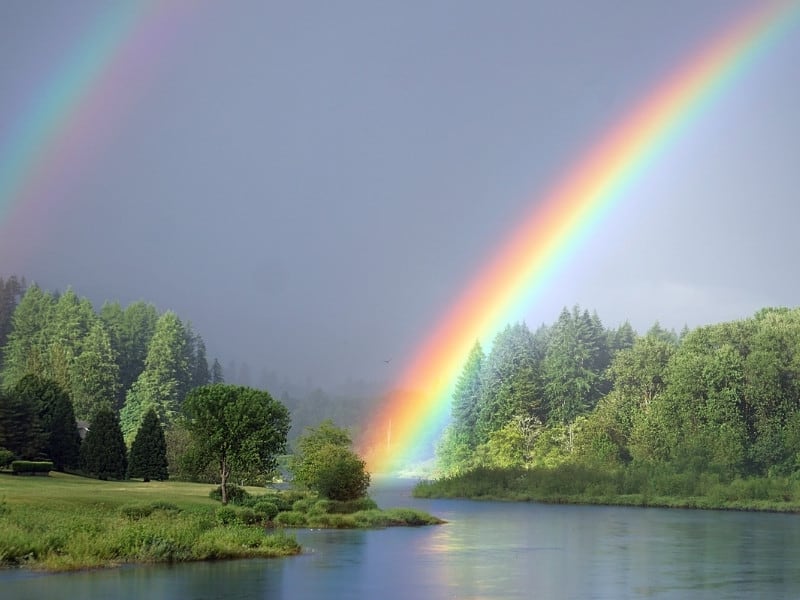Discover the colors of the rainbow and the rainbow colors meanings – what they symbolize in different cultures.
Rainbows are one of nature’s most beautiful phenomena, but they represent more than just sunlight entering raindrops.
The meanings of the rainbow’s colors in different cultures are as fascinating as the rainbow’s colors themselves.
Colors are amazing and can change moods and emotions, especially when positioned in an arc across the sky.
If you ask different people about the meanings of rainbow colors, you will most likely get different answers.
Aside from color psychology, the energies that colors carry are important because they can influence our health and mood.
The rainbow has symbolic meaning in many cultures, which is why we will discuss the rainbow colors meanings in various religions and cultures around the world, as well as their relationship with the Chakra system.
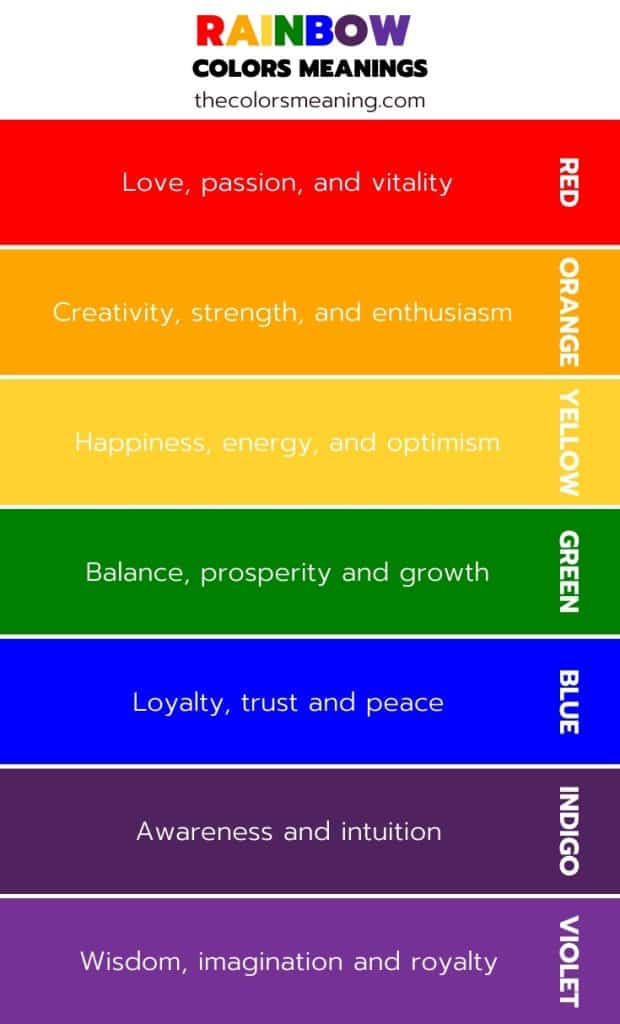
To embed this infographic on your website, copy and paste the code below. Otherwise, no usage rights will be granted.
<img src="https://thecolorsmeaning.com/wp-content/uploads/2022/11/rainbow-colors.jpg" alt="rainbow color meanings" width="800px" border="0"><small>Like this? Discover more about the <a href="https://thecolorsmeaning.com/color-blue-meaning-of-the-color-blue" rel="noopener" target="_blank">rainbow color meanings</a> from <a href="https://thecolorsmeaning.com" rel="noopener" target="_blank">TheColorsMeaning.com</a></small>What is a Rainbow?
The rainbow is a multicolored arc formed by light (through reflection, refraction and dispersion) striking the water droplets.
Created by the sunlight and atmospheric conditions, the rainbow is probably the most beautiful meteorological phenomenon. Reflection, refraction, and dispersion of the light in water droplets lead to the appearance of rainbows.
This spectacular spectrum of light that appears in the sky takes the form of a circular arc made up of 7 colors perceived by the human eye.
A rainbow is most commonly formed when sunlight strikes raindrops at a 42-degree angle.
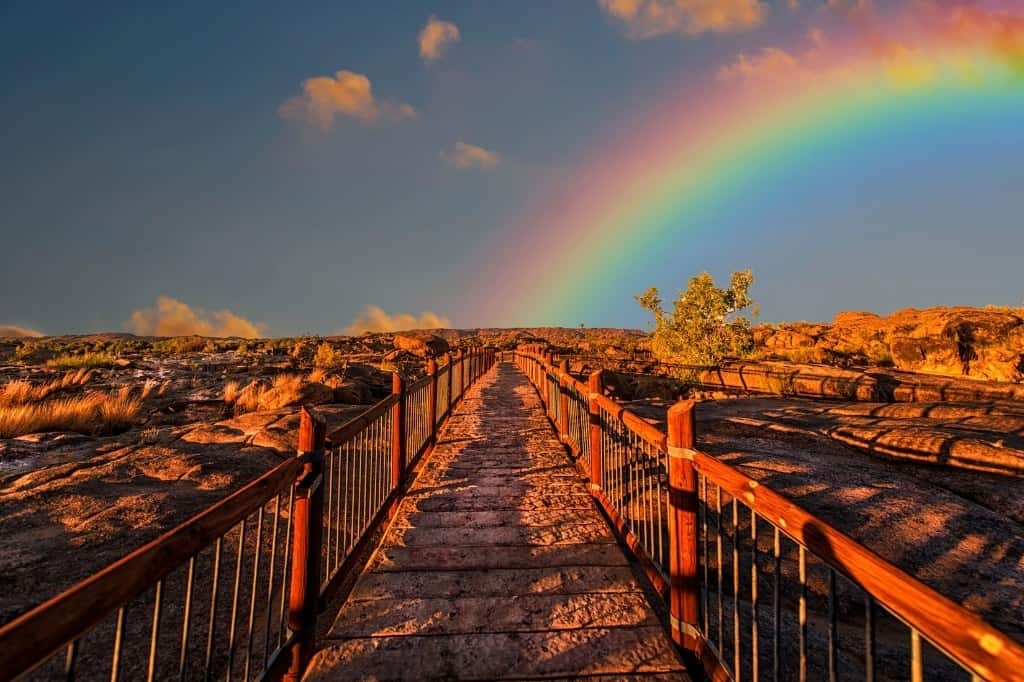
You can also see rainbows when there is fog or a waterfall in the area.
The rainbow is an optical illusion because it does not exist in any specific location in the sky. Instead, the sun is usually behind the person who is seeing the rainbow.
Rainbows can be single, with a single reflection in the water droplet, or double, with light reflected twice in the water droplet.
Furthermore, rainbows come in various forms, including the fog rainbow, which appears when sunlight passes through a cloud or enters the fog, and the lunar rainbow, which appears on a full moon.
The rainbow colors meanings are either psychological or religious in most cultures.
Rainbow colors are often associated with the chakra color system, aura colors, angel colors, and even days of the week.
What Are the Colors of the Rainbow?
- Red
- Orange
- Yellow
- Green
- Blue
- Indigo
- Violet
The seven colors of the rainbow are red, orange, yellow, green, blue, indigo, and violet.
Each rainbow that appears in the sky will have these colors in the above order. Scientists call the colors of the rainbow as ROYGBIV (pronounced Roy G. Biv). However, some scientists consider the color indigo too close to blue to be truly distinguishable.
Using ROYGBIV, we can easily remember the colors of the rainbow and their order, each letter representing the first letter of each color.
A lesser-known fact to people is that although the rainbow is known to have seven colors, it is actually made up of over 1 million colors. Most of these colors cannot be perceived by the human eye.
Let’s discover the rainbow colors meanings!

Rainbow Colors in Religions and Cultures
Rainbows are really fascinating. In many cultures, the rainbow colors meanings are associated with hope and the promise of better times ahead.
The rainbow has many religious and spiritual meanings. In some cultures, rainbows were thought to be a sign of good luck or even a messenger from the gods.
Let’s discover the rainbow colors meanings in various religions and cultures by reading on.
The Rainbow in Religion
The rainbow colors symbolize a variety of concepts in religions, including hope for better times (Christianity), the four elements (Islam), divine patience (Judaism), and the four vital elements (Islam).
The rainbow is associated with hope in the Bible and is thought to be a message from God.
The biblical meaning of the rainbow is derived from its appearance after the Great Flood when it appeared to Noah.
As a result, the appearance of a rainbow after a storm is associated with the biblical meaning that God will not destroy the world through the flood again.
A rainbow is mentioned in the book of Revelation as a sign of the second coming of Jesus Christ.
In Christianity, the Color of Angels is used to focus on prayer. As a result, it is believed that some people have the grace to see beyond the colors of the rainbow.
Aristotle, along with his first color theory, considered the rainbow to be the image of the sun reflected from a cloud.
Rainbows had various meanings in Native American culture, depending on the tribe. While some tribes saw rainbows as a link between the physical and spiritual worlds, others considered them a symbol of healing goddesses.
The Maya Indians had a similar understanding of rainbows to Christians: after their world was destroyed by a rain of fire, the appearance of the rainbow meant that the gods were no longer angry.
Blue, green, red, and yellow were associated with the elements of water, Earth, fire, and air in Islam.
The rainbow is considered in Judaism as a representation of divine patience.
Buddhists believed that the rainbow’s colors represented the seven continents.
The Rainbow in Different Cultures
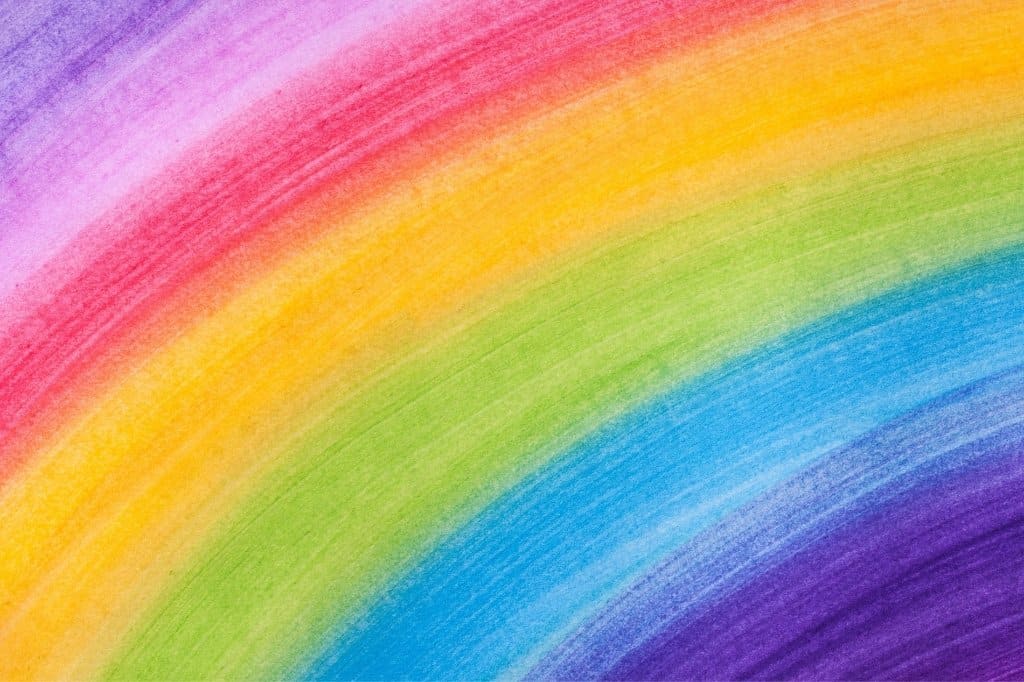
Rainbow colors meanings are similar in many cultures, representing good luck, hope, prosperity, peace, gratitude, and tolerance.
Rainbow colors are associated with hope in Western culture and art, representing a promise of better times.
In Irish culture, the meaning of the rainbow is associated with pots of gold and leprechauns. According to an Irish legend, the end of the rainbow represents the location where the leprechauns buried a pot of gold stolen from the Vikings.
A similar meaning can be found in Polish culture: golden pots are received as angelic gifts.
In other cultures, the rainbow represents bridges or paths. For example, the Romans believed that rainbows were the path taken by Mercury, the messenger god.
In Norse mythology, the rainbow was a burning bridge that connected humans to the gods’ kingdoms of Asgard and Midgard.
According to Norse mythology, only warriors and gods can cross the rainbow bridge.
In Japanese mythology, the rainbow is associated with a floating bridge to heaven. In contrast, in Chinese mythology, the rainbow is a crack in the sky made of five colored stones cast by Nüwa, the mother goddess.
In Hawaiian culture, rainbows are a bridge between the physical and spiritual worlds. They show the way to the afterlife.
Rainbows are now used metaphorically to connect disparate cultures or communities. Members of the LGBT+ community use rainbow colors in Pride flags to represent their values.
The rainbow’s colors represent human-Earth coexistence and are used in the illustrations of worldwide ecological associations.
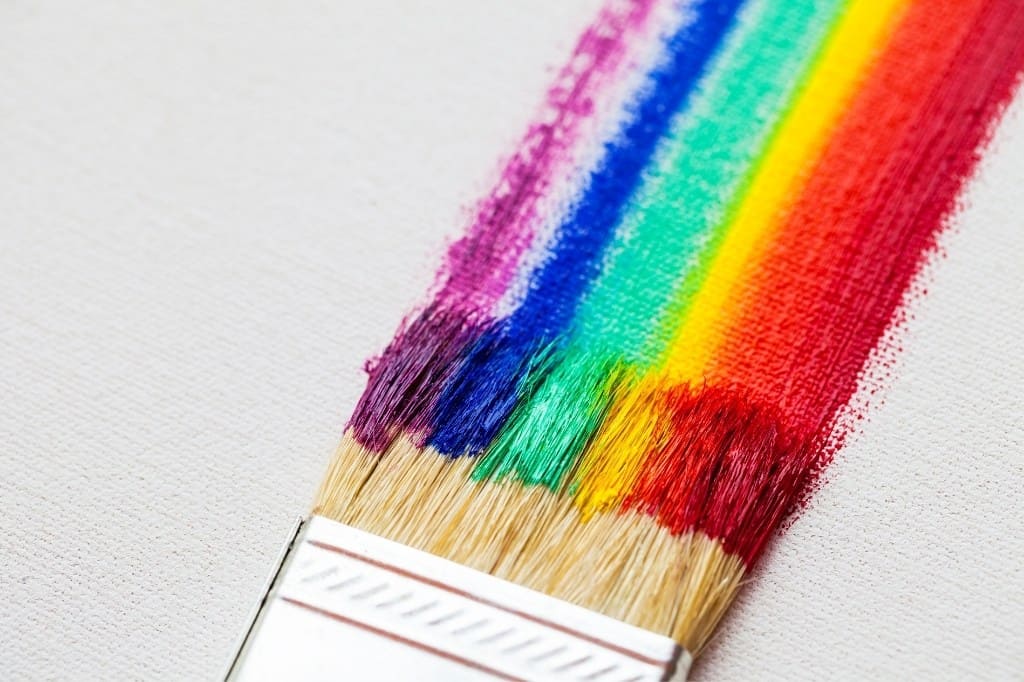
Eastern Europeans, particularly Bulgarians, believe that walking under a rainbow can alter your gender.
While many cultures regard the rainbow as a beautiful natural phenomenon, some Mesoamerican societies regard it as a bad omen.
For example, the Karen people of Burma consider hiding their children when a rainbow appears out of fear that the children will be eaten.
In Peruvian culture, the rainbow is associated with bad spirits that cause abortions.
The Aborigines of Australia considered the rainbow a snake that controls monsoons and rain by absorbing water. Likewise, the Shoshoni people of North America believe that the rainbow is a snake that dislodges chunks of ice to cause rainfall.
The Semang people of Malaysia have a similar understanding of the rainbow, seeing it as a small visible part of a giant snake.
Some Mayans believe that rainbows bring bad luck, while others believe that they are a sign from the gods.
Rainbow Facts
Rainbows are one of the most fascinating weather phenomena in nature. Here are some of the most captivating rainbow facts.
- In 350 BC, the Greek philosopher Aristotle discovered the rainbow. Senaca later predicted the discovery of the prism effect, which was discovered much later by Newton.
- The rainbow is made up of tiny drops of water and light.
- Two people see the same rainbow in two different ways.
- Light reflected twice in a raindrop creates a double rainbow.
- The rainbow is an optical illusion because it does not have a fixed location in the sky.
- The term “rainbow” comes from the words “renboga,” which means “rain,” and “bogan,” which means “arch”.
- Until the 17th century, it was thought that the rainbow was made up of red, blue, green, and yellow colors. Indigo and violet were later added by Isaac Newton.
- Rainbows represent peace.
- The majority of rainbows are seen in Hawaii.
- Rainbows are a meteorological phenomenon that occurs only on Earth, throughout the entire solar system.
- Rainbows were thought by the Greeks to be the way from the gods.
- The longest rainbow was discovered in the Taipei Mountains and lasted about 9 hours.
Meaning of the Rainbow Colors
Red
Red is the first color in the rainbow and symbolizes vitality and passion.
The color Red – a primary color, is a warm color with the longest wavelength of all the rainbow colors. Red is one of the rainbow colors with the most meanings.
Red is a vibrant color packed with strong emotions. The red color of the rainbow represents enthusiasm, passion, and confidence.
Christians associate red with energy and wisdom. Buddhists and Hindus associate red with the Muladhara chakra, which represents grounding.
The meaning of the rainbow’s red color is also associated with energy and wisdom in Christianity, as it resembles the Archangel Uriel.
Red is a color associated with strong feelings and emotions, in addition to its religious significance.
Every society uses red to indicate danger or to issue warnings. Red is also used to stop cars at traffic lights.
As a result, red is a color that easily draws attention.
Red is used in literature to represent war and hostile acts. Red is also associated with passion. The best example is red roses, which represent a form of love.
Japan and China revere the color red woven into the rainbow’s colors. Chinese brides, who traditionally wore red, may be an example of this.
Orange
The second arc of the rainbow is orange, which is created by combining red and yellow. As a result, this color combines the happiness of yellow with the vitality of red.
Orange is a welcoming, vibrant, and cheerful color that makes people feel comfortable and relaxed.
Rainbow orange is a color that symbolizes endurance, strength, and perseverance.
The color orange represents creativity and enthusiasm.
Orange is associated with the orange chakra, also known as the Swadhisthana Chakra, in the chakra system. This chakra is associated with creativity and fertility.
Furthermore, orange is associated with Archangel Gabriel through the orange ray of spiritual enlightenment, which symbolizes the sense of art and creativity.
Last but not least, orange is associated with the ability to enjoy life.
Although not all orange shades have the same meaning, the color burnt orange represents tension and aggression, while peachy orange is associated with politeness. Ambition is represented by dark orange. Self-control is related to the golden orange.
Yellow
Yellow, the third color of the rainbow, is the color of the sun and represents happiness.
Yellow is a vibrant, beautiful color associated with creativity, energy, communication, and warmth.
The color yellow in the rainbow stands for joy and energy.
The yellow arc is spiritually associated with the archangel Jopiel, who represents brightness and good thoughts.
Yellow is used to depict a happy life and can be found in various forms in our society, including lemons, bees, eggs, and sunflowers.
Yellow stands out, which is why it is one of the most easily recognized colors in the rainbow.
Yellow is associated with the yellow chakra, which is also known as the Solar Plexus Chakra or Manipura, which is the seat of the ego. Here is where our self-esteem is defined.
Green
The color green, the middle color of the rainbow, is an energizing and lush color that represents growth, life, and balance.
The third color of the rainbow, known as the color of life, is associated with the green chakra, which represents love, transformation, and growth.
Green is associated with Raphael, the archangel of healing and prosperity.
Furthermore, green has become a symbol of all things ecological as a color of nature.
As a result, the color green of the rainbow is associated with nature, growth, health, and abundance.
Blue
Blue is associated with the sky and the sea, representing peace, stability, spirituality, freedom, and relaxation.
Blue, the color of the ocean, is frequently used to convey loyalty and trust.
Blue is a color associated with the blue chakra, representing the ability to express yourself and communicate with those around you without fear. Vishuddha, the Sanskrit word for blue chakra, represents purification.
Thus, the blue color of the rainbow symbolizes peacefulness, tranquility, and the ability to communicate with purity.
Indigo
Indigo is a unique color that represents intuition and psychic abilities. The hue is one of the prismatic colors of light, according to Isaac Newton. However, many scientists disagree with this rainbow color and refer to it as a blue shade created by combining 3/4 blue and 1/4 violet.
The indigo color is obtained by crushing the indigo-containing leaves and then fermenting them in water.
The color of the midnight sky is thus created by combining blue and purple. The meaning of the color indigo is to encourage people to think deeply, with spiritual implications.
Indigo is the rainbow color that represents awareness and wisdom, and it is the spiritual bridge between the subconscious and consciousness.
It is linked to the Ajna, or indigo chakra, located between the brows. This chakra is associated with awareness, clarity, intuition, and knowledge.
Indigo should be used with caution because too much of it can make you feel intolerant, critical, anxious, and frustrated.
Violet
Violet, also known as purple, is one of the rainbow’s most appreciated colors.
Violet, the polar opposite of red, has the shortest visible color wavelength and is the most subtle of the colors.
The color violet, a combination of red and blue, represents creativity and support in experiencing harmony and spiritual oneness with lifeforms.
This rainbow color is represented in the chakra system by the Sahasrara or violet chakra, which is known as the most powerful energy center of all the chakras.
Final Thoughts on Rainbow Colors
After going through the rainbow colors meanings, it becomes clear that the rainbow is a magical phenomenon beyond science.
By learning the meanings of the rainbow’s colors in other cultures, the next time you see a rainbow, stop and take time for yourself to admire it.

